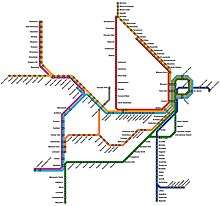Sydney Trains
Sydney Trains is the operator of the suburban passenger rail network serving the city of Sydney, New South Wales, Australia. The network is a hybrid urban-suburban rail system with a central underground core that covers over 813 km (505 mi) of track and 175 stations over eight lines. It has metro-equivalent train frequencies of every three minutes or better in the underground core, 5–10 minutes off-peak at most inner-city and major stations and 15 minutes off-peak at most minor stations. During weekday peak services trains are more frequent, while frequency decreases on weekends.[1]
 | |||
.jpg) Series 2 Waratah at Panania | |||
 System icon | |||
| Overview | |||
|---|---|---|---|
| Owner | Transport for NSW | ||
| Locale | Sydney | ||
| Transit type | Suburban rail | ||
| Number of lines | 8 | ||
| Number of stations | 175 | ||
| Annual ridership | 377.1 million (2018–2019) | ||
| Chief executive | Suzanne Holden (Acting Chief Excutive) | ||
| Website | Transport for NSW: Sydney Trains | ||
| Operation | |||
| Began operation | 1 July 2013 | ||
| Operator(s) | Sydney Trains | ||
| Technical | |||
| System length | 813 km (505 mi) | ||
| Track gauge | 1,435 mm (4 ft 8 1⁄2 in) standard gauge | ||
| Electrification | 1500 V (DC) overhead line | ||
| |||
The network is controlled by Transport for NSW, and is part of its Opal ticketing system. In 2018–19, 377.1 million passenger journeys were made on the network.
History
In May 2012 the Minister for Transport announced a restructure of RailCorp, the organisation that owned and managed the metropolitan rail network and operated passenger services throughout New South Wales.[2][3][4][5] Two new organisations were created to take over operation of the services from 1 July 2013. Sydney Trains acquired all suburban services in the Sydney metropolitan area bounded by Berowra, Emu Plains, Macarthur and Waterfall from RailCorp's CityRail division. Intercity and Hunter Line services previously operated by CityRail were taken over by NSW Trains (branded as NSW TrainLink).[6] RailCorp remained as the owner of the network infrastructure. When first created as subsidiaries of RailCorp, Sydney Trains and NSW Trains were not controlled entities of RailCorp, but were instead controlled by Transport for NSW.[7] In July, they ceased to be subsidiaries of RailCorp and became independent standalone agencies in July 2017.[8][9]
Network changes
The first expansion of the Sydney suburban network during the Sydney Trains era occurred in 2015 when the South West Rail Link opened between Glenfield and Leppington.
Beginning in 2018, some sections of the network are being transferred to the city's metro and light rail networks. The T1 Line between Chatswood and Epping was closed for conversion in September 2018 to form part of Sydney Metro Northwest.[10] The section of the T6 Carlingford Line between Camellia and Carlingford closed in January 2020 and will form part of the Parramatta Light Rail network.[11] The adjacent section of track between Clyde and Camellia, including Rosehill railway station, also became disused.[12] The light rail is expected to open in 2023.[11] The section of line between Sydenham and Bankstown will form part of Sydney Metro City & Southwest. This is due to open in 2024.[13]
Operations
In July 2013, Howard Collins, the former Chief Operating Officer of London Underground, was appointed as Chief Executive of Sydney Trains. Stewart Mills was appointed Acting Chief Executive in February 2020, succeeded by Suzanne Holden as Acting Chief Executive in June 2020.
In addition to operating suburban train services, Sydney Trains maintains the New South Wales Metropolitan Rail Area, and maintains all but a handful of operational railway stations in the state.
Network
Sydney Trains operates electric suburban lines across metropolitan Sydney.
In conjunction with a new timetable released on 20 October 2013, the Sydney Trains network was reorganised with a new numbering system. The number of lines was reduced from eleven to seven by merging several lines.
An eighth line was created on 26 November 2017 by splitting the T2 line into two separate lines. T5 services were also modified to no longer travel to and from Campbelltown, instead starting and terminating at Leppington.[14]
From 28 April 2019, the T1 line from Gordon to Hornsby via Strathfield was renumbered T9, whilst the portion from Berowra to Richmond & Emu Plains via Chatswood and Parramatta remained T1. T9 is red in colour.[15]
The T6 Carlingford line, which operated between Clyde and Carlingford, ceased operations on 5 January 2020.
| Line colour, number and name | Between | |
|---|---|---|
| North Shore & Western Line | ||
| Inner West & Leppington Line | ||
| Bankstown Line | 🌍 | |
| Eastern Suburbs & Illawarra Line | 🌍 | |
| Cumberland Line | 🌍 | |
T7 | Olympic Park Line | 🌍 Some services operate between Central and Olympic Park, particularly during special events. |
| Airport & South Line | 🌍 | |
| Northern Line | Hornsby and Gordon via Strathfield and City | |
The main hub of the Sydney Trains system is Central station, which most lines pass through. Central is also the terminus of most NSW TrainLink lines. After leaving Central, trains coming from the T2 Inner West & Leppington Line, T3 Bankstown Line and T8 Airport & South Line then travel through the City Circle - a ring line beneath the Sydney central business district. After completing the City Circle, these trains pass through Central for a second time and return to the suburbs. The T1 North Shore & Western, T4 Eastern Suburbs & Illawarra and T9 Northern lines pass through the central business district and continue on to other areas of Sydney. The T5 Cumberland Line serves Western Sydney and provides access to the major centre of Parramatta from the south west of the city without requiring a change of trains at Granville. The T7 Olympic Park Line is a suburban shuttle service.
NightRide
NightRide bus services established in 1989, replace trains between midnight and 4:30am, leaving the tracks clear of trains for maintenance work. Such bus services mainly stop near stations operating typically at hourly intervals (some routes depart more frequently on weekends). Many services depart the city from bus stops near Town Hall station.[16] NightRide services are contracted to external bus operators and are identified by route numbers beginning with "N".
Fleet
Sydney Trains operates a fleet of double deck electric multiple units. The trainsets are divided into the following classes:
| Class | Carriages | Entered Service | Formation | Routes | Image |
|---|---|---|---|---|---|
| K sets | 160 | 1981-85 | 4 cars | T7 |
 |
| C sets | 56 | 1986-87 | 4 cars | .jpg) | |
| T sets | 447 | 1988-95 | 4 cars | T7 |
 |
| M sets | 140 | 2002-05 | 4 cars | 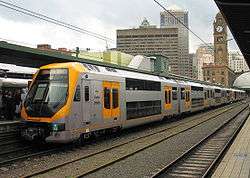 | |
| H sets | 220 | 2006-12 | 4 cars |  | |
| A sets | 626 | 2011-14 | 8 cars | T7 |
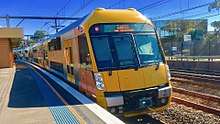 |
| B sets | 192 | 2018-19 | 8 cars | T7 |
.jpg) |
Though primarily operated by NSW TrainLink, some H sets are also used on suburban services, and with the delivery of the D sets for operations on regional NSW TrainLink lines from 2020, most of the sets will be transferred to suburban services. The oldest sets in the fleet, the S sets, were all pulled out of service and scrapped with the delivery of 24 B sets, which was completed in June 2019.
All Sydney Trains A, B and M sets are maintained by Downer Rail. Their contract for the Millenium trains (M sets) was extended by 10 years from June 2017.[17] All other types of trains including NSW TrainLink intercity V and H sets are maintained by UGL Unipart. The contract with UGL Unipart was extended for two years from 1 July 2019.[18]
The Sydney Trains network is divided into three sectors, based around three maintenance depots.[19] Trainsets are identified by target plates, which are exhibited on the front lower nearside of driving carriages.[20] Each target plate includes the letter of the class the set belongs to and the number of the individual set. Waratahs do not have a target plate, but instead, have the information written directly on the front of the train. The composition and formations of train sets and the target designations are subject to alteration. NSW TrainLink H sets carry green target plates.
| Sector # | Depot | Serviced lines | Target plate | Sets being maintained |
|---|---|---|---|---|
| 1 | Mortdale | T4 Eastern Suburbs & Illawarra line, Intercity services on the South Coast line. | Red | T, H |
| 2 | Flemington | T2 Inner West & Leppington, T3 Bankstown, T5 Cumberland, T7 Olympic Park and T8 Airport & South lines, Intercity services on Blue Mountains & Central Coast lines (V sets only). |
Blue | K, C, V |
| 3 | Hornsby | T1 North Shore & Western and T9 Northern lines, Intercity services on the Central Coast line (H sets only) | Black | T, H |
| N/A | Auburn Maintrain | UGL Unipart carry out maintenance at the various depots to which the trains are allocated but major work may be carried out at Auburn Maintrain. | N/A | All except A, B and M |
| N/A | Auburn | All A, B and M sets are stabled at the depot for the sector in which they operate but are maintained at Auburn by Downer Rail. | N/A | A, B, M |
Patronage
The following table lists patronage figures for the network during the corresponding financial year. Australia's financial years start on 1 July and end on 30 June. Major events that affected the number of journeys made or how patronage is measured are included as notes.
| Year | 2013-14 | 2014-15 | 2015-16 | 2016-17 | 2017-18 | 2018-19 | 2019-20 |
|---|---|---|---|---|---|---|---|
| Patronage (millions) |
282.2 [lower-alpha 1] |
291.9 [lower-alpha 2] |
322 | 340.7 [lower-alpha 3] |
359.2 | 361.1 [lower-alpha 4] |
282.0 [lower-alpha 5] |
| References | [21] | [22] | [23] | [24] | [25] | ||
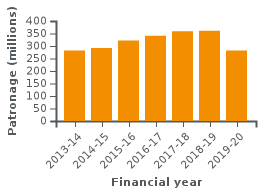 | |||||||
- Opal rollout completed in March 2014.
- South West Rail Link opened in February 2015.
- Non-Opal tickets were discontinued in August 2016.
- Epping to Chatswood Rail Link closed in September 2018. Patronage figures includes Station Link but excludes Sydney Metro
- The T6 Carlingford Line ceased operations in January 2020. Additionally, patronage was lower than previous years due to people staying at home and not taking public transport to school or work during the COVID-19 pandemic
| 88 073 000 |
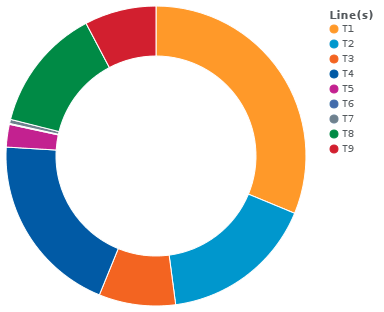 | |
| 46 992 000 | ||
| 23 287 000 | ||
| 55 784 000 | ||
T5 |
6 854 000 | |
| † | 294 000 | |
| 1 244 000 | ||
| 37 650 000 | ||
| 21 765 000 |
- Figures based on Opal tap on and tap off data.
†= T6 Carlingford Line ceased operations in January 2020. Figure exclude rail replacement bus 535.
Metro |
18 892 000 |
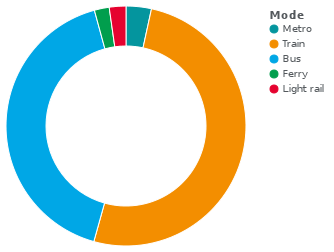 |
Train |
282 022 000 | |
Bus |
229 532 000 | |
Ferry |
11 083 000 | |
Light Rail |
12 374 000 |
Ticketing and costs
Sydney Trains currently uses the Opal card ticketing system which was introduced to the network in April 2014.[28] The fare system is fully integrated with the Sydney Metro network and the NSW TrainLink Intercity network - trips involving suburban, metro and intercity services are calculated as a single fare and there is no interchange penalty. Students who use the Sydney Trains network to get to and from schools can apply for a free school Opal card. Opal is also valid on bus, ferry, and light rail services but separate fares apply for these modes. The following table lists Opal fares for reusable smartcards and single trip tickets:[29]
| As of 6 July 2020 | 0–10 km | 10–20 km | 20–35 km | 35–65 km | 65 km+ |
|---|---|---|---|---|---|
| Adult cards & contactless (peak) | $3.61 | $4.48 | $5.15 | $6.89 | $8.86 |
| Adult cards & contactless (off-peak) | $1.80 | $2.24 | $2.57 | $3.44 | $4.43 |
| Other cards (peak) | $1.80 | $2.24 | $2.57^ | $3.44^ | $4.43^ |
| Other cards (off-peak) | $0.90 | $1.12 | $1.28 | $1.78 | $2.21 |
| Adult single trip | $4.50 | $5.60 | $6.40 | $8.40 | $10.80 |
| Child/Youth single trip | $2.20 | $2.80 | $3.20 | $4.20 | $5.40 |
^ = $2.50 for Senior/Pensioner cardholders
A surcharge is levied when using the two privately operated stations serving Sydney Airport:
| As of 17 February 2020[30] | Adult cards | Other cards |
|---|---|---|
| Domestic or International Airport to/from all other stations | $14.87 | $13.18 |
| Domestic or International Airport to/from Green Square | $8.97 | $8.97 |
| Domestic or International Airport to/from Mascot | $6.57 | $6.57 |
| Domestic to/from International | $2.20 | $2.20 |
As there are no return or periodical options available, reusable Opal cards include a number of caps to reduce the cost for frequent travellers:
| As of 6 July 2020[31][32][33] | Adult cards | Other concession cards | Senior/Pensioner cards |
|---|---|---|---|
| Daily Mon-Fri | $16.10 | $8.00 | $2.50 |
| Daily Saturday and Sunday | $8.05 | $4.00 | $2.50 |
| Weekly | $50.00 | $25.00 | $17.50 |
| Weekly Airport Station Access Fee |
$30.16 | $26.78 | $26.78 |
The previous ticketing system was introduced in 1992 and was based on magnetic stripe technology. It was shut down on 1 August 2016.[34]
See also
References
- "Train timetables". Transport for NSW.
- "RailCorp job cuts first of many: unions" Sydney Morning Herald 15 May 2012
- "Ruthless RailCorp reforms planned as middle management axed" Daily Telegraph 15 May 2012
- Corporate Plan 2012/13 RailCorp
- 700 jobs to go as RailCorp gets the axe Daily Telegraph 16 November 2012
- About the Reform Sydney Trains
- "Railcorp Annual Report 2013-14" (PDF). Transport for NSW. p. 15. Archived (PDF) from the original on 13 September 2018. Retrieved 21 December 2018.
- "Transport for NSW Annual Report 2017-18" (PDF). Transport for NSW. p. 49. Retrieved 2 December 2018.
- Transport Administration Amendment (Transport Entities) Act 2017 No 12 Schedule 1, Legislation NSW, Retrieved 18 December 2018
- "Station Link bus services to connect customers during Metro upgrade". transportnsw.info. Transport for NSW. 7 April 2018.
- "Parramatta Light Rail – Stage 1: Connecting great places" (PDF). Transport for NSW. March 2017. Retrieved 7 June 2017.
- "Parramatta Light Rail | Stage 1 – Westmead to Carlingford via Camellia: Environmental Impact Statement" (PDF). Transport for NSW. pp. 5–65, 5–66. Retrieved 24 August 2017.
- "Sydney Metro". Transport for NSW. Retrieved 27 July 2016.
- "More Trains, More Services for South Western Sydney" (PDF). Transport for NSW. Government of New South Wales. 27 February 2017. Retrieved 27 February 2017.
- O'Sullivan, Matt (21 February 2019). "A New Red Line Through Sydney's Rail Map". Sydney Morning Herald. Retrieved 21 February 2019.
- Section, Transport for NSW, Customer Experience Division, Customer Service Branch, Customer Information Services. "Late night services". transportnsw.info. Retrieved 14 April 2018.
- Millenium maintenance contract extension Downer Rail] 28 February 2017
- UGL secures $277M extension with Sydney Trains UGL 31 January 2019
- "Train Fleet Maintenance". CityRail. 1 June 2006. Archived from the original on 13 March 2008. Retrieved 18 May 2008.
- Department of Railways, New South Wales: Working of Electric Trains, 1965
- "Transport for NSW Annual Report 2014-15" (PDF). Transport for NSW. p. 131. Retrieved 1 August 2016.
- "Sydney Trains 2015-16 Annual Report Volume 1" (PDF). Sydney Trains. p. 3. Archived from the original (pdf) on 10 May 2017. Retrieved 18 November 2016.
- "Sydney Trains Annual Report 2016-17" (PDF). Transport for NSW. p. 4. Retrieved 24 November 2017.
- "Sydney Trains Annual Report 2017-18" (PDF). Sydney Trains. p. 4. Retrieved 2 December 2018.
- "Train Patronage - Monthly Figures". Transport for NSW. Retrieved 7 August 2020.
- "Train Patronage - Monthly Figures". Transport for NSW. Retrieved 7 August 2020.
- See Transport for NSW patronage in Sydney by mode for sources
- "Archived copy". Archived from the original on 3 March 2014. Retrieved 28 March 2014.CS1 maint: archived copy as title (link)
- "Opal fares". transportnsw.info. Transport for NSW. Retrieved 22 June 2019.
- "Getting to and from Sydney Airport". transportnsw.info. Transport for NSW. Retrieved 17 February 2020.
- "Opal benefits". opal.com.au. Transport for NSW. Retrieved 2 July 2018.
- "Getting to and from Sydney Airport". transportnsw.info. Transport for NSW. Retrieved 17 February 2020.
- "Passenger Transport (Opal and Other Fares) Amendment Order 2020" (PDF). legislation.nsw.gov.au. NSW Government. Retrieved 5 July 2020.
- "No more paper tickets | NSW Government | Opal". www.opal.com.au. Retrieved 20 July 2016.
External links
| Wikimedia Commons has media related to Sydney Trains. |
